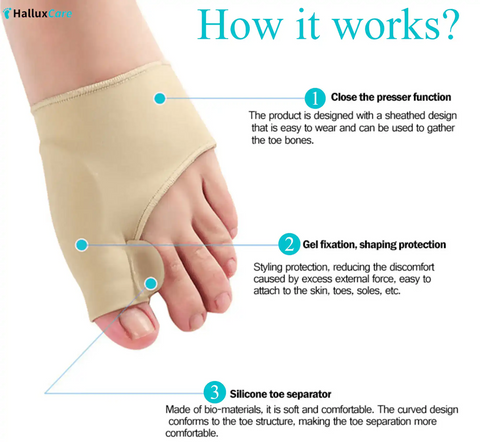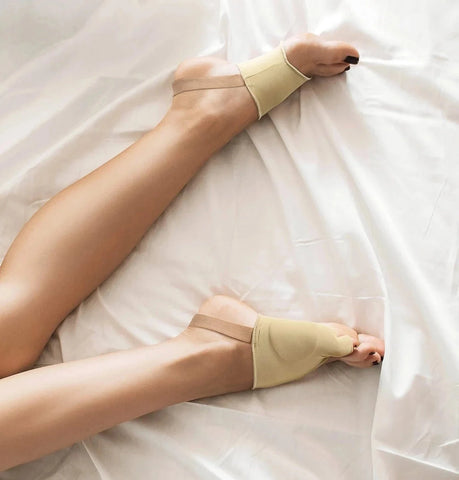Understanding Foot Pain: Why You Should See a Podiatrist Before Self-Diagnosing
Last updated: 2025-11-23T04:13:36.103Z
Author: Dr. Emily Harper, DPM (Doctor of Podiatric Medicine)
Foot pain can be confusing due to the foot’s complex structure, including 26 bones and over 100 muscles, tendons, and ligaments. If you experience foot pain, the best first step is to see a podiatrist for an accurate diagnosis rather than guessing. Proper evaluation helps determine the cause and guides effective treatment.
Key Takeaways
- Foot pain has many causes, including bunions, gout, plantar fasciitis, and flat feet.
- Self-diagnosis is unreliable; professional assessment with imaging is essential.
- Orthopedic aids like bunion sleeves can reduce pain and support foot alignment.
- Proper footwear with a wide toe box and low heels helps prevent worsening pain.
- Exercises and daily routines may support foot health alongside medical treatment.
- Early podiatrist consultation improves outcomes and prevents complications.
What Is a Bunion (Hallux Valgus) and Bunionette (Tailor’s Bunion)?
A bunion (hallux valgus) is a deformity where the big toe angles inward toward the second toe, often causing a painful bony bump on the side of the foot. A bunionette (tailor’s bunion) is a similar bump occurring at the base of the little toe. Both conditions can cause discomfort, shoe irritation, and progressive misalignment of toes [1].
Symptoms and When to Seek Care
Common symptoms of bunions and other foot conditions include:
- Visible bump or swelling at the base of the big or little toe
- Pain or tenderness around the affected joint
- Redness or inflammation
- Difficulty fitting shoes comfortably
- Numbness or restricted toe movement
If you experience persistent foot pain, visible deformities, or difficulty walking, consult a podiatrist promptly. Early diagnosis can prevent worsening and guide treatment options [2].
Conservative Management Options and Product Use Guidance
Podiatrists often recommend non-surgical treatments first, including:
- Orthopedic bunion sleeves and toe spacers to cushion and realign toes gently.
- Protective padding to reduce friction and pressure inside shoes.
- Topical soothing oils, like Jamaica Black Castor Oil, to moisturize skin and reduce inflammation.
- Targeted exercises to improve toe flexibility and foot strength.
Using medical-grade sleeves like the Orthopedic Bunion Pain Relief & Correction Sleeve can reduce pain and slow deformity progression [3]. The Tailor's Bunion Bunionette Pain Relief Protection Sleeves offer similar benefits for bunionettes.
Fit and Footwear Tips for Bunion Relief
Proper footwear is critical to managing bunions and foot pain:
- Choose shoes with a wide toe box to avoid crowding the toes.
- Select soft, flexible materials like leather or mesh to reduce irritation.
- Opt for low heels (under 2 inches) to minimize forefoot pressure.
- Avoid pointed or tight shoes that aggravate bunions and bunionettes.
Wearing well-fitted shoes can prevent symptoms from worsening and improve comfort during daily activities [4].
Exercises and Daily Routines to Support Foot Health
Incorporate these simple routines to maintain foot mobility and strength:
- Toe stretches: Gently pull and spread toes apart to maintain flexibility.
- Toe curls: Use toes to pick up small objects, strengthening muscles.
- Foot rolls: Massage the arch with a tennis ball to relieve tension.
- Ankle circles: Improve overall foot and ankle mobility.
Perform exercises daily for best results and complement them with orthopedic aids as recommended by your podiatrist [5].
How to Use Orthopedic Bunion Sleeves: A Simple Routine
- Choose a clean, dry foot before application.
- Slide the sleeve over the foot, positioning the cushioned area around the bunion.
- Wear the sleeve during activities or while resting, as advised by your podiatrist.
- Remove and wash the sleeve regularly to maintain hygiene.
- Combine sleeve use with proper footwear and exercises for optimal relief.
Recommended HalluxCare Bunion Products:
4.9 ⭐⭐⭐⭐⭐ ( 1843 reviews )
Frequently Asked Questions (FAQs)
Are toe spacers safe for bunions?
Yes, toe spacers are generally safe when used as directed. They help realign toes and reduce pressure on the bunion, but should be used under guidance to avoid discomfort or injury [6].
How long should I wear toe spacers daily?
Start with short periods, such as 30 minutes, and gradually increase as tolerated. Many people use them during rest or low-activity times, but follow your podiatrist’s advice for best results.
Bunion vs tailor’s bunion – what’s the difference?
A bunion (hallux valgus) affects the big toe joint, causing it to angle inward. A tailor’s bunion (bunionette) affects the little toe side of the foot, creating a bump near the fifth metatarsal. Both involve similar symptoms but different locations [1].
Do bunion sleeves help with shoe comfort?
Yes, bunion sleeves cushion the area, reducing friction and pain inside shoes. They can make wearing shoes more comfortable and protect skin from irritation.
When should I see a podiatrist?
See a podiatrist if you have persistent foot pain, visible deformities, difficulty walking, or if home treatments aren’t helping. Early evaluation is key to preventing complications.
Can I run or play pickleball with a bunion?
You can often continue activities with proper footwear and support. However, high-impact sports may worsen bunion pain, so consult your podiatrist for personalized advice and protective measures.
Final Thoughts: Don’t Guess—Get the Right Diagnosis and Care
Foot pain should never be self-diagnosed. The foot’s complex anatomy means that professional assessment by a podiatrist is essential. Proper diagnosis guides effective treatment, including orthopedic supports like bunion sleeves, footwear adjustments, and exercises to improve comfort and function. Take care of your feet with expert guidance and the right tools.
What has your experience been with foot pain and treatments? Have you tried orthopedic sleeves or professional consultations? Share your story in the comments below!
Glossary of Key Terms
- Bunion (Hallux Valgus): Deformity causing the big toe to lean inward, forming a bony bump.
- Bunionette (Tailor’s Bunion): Similar bump on the outside of the little toe.
- Toe Spacers: Devices placed between toes to realign and reduce pressure.
- Bunion Sleeves: Cushioned sleeves that protect the bunion and support toe alignment.
- Orthoses: Custom or over-the-counter devices that support foot structure and function.
Sources
- American Orthopaedic Foot & Ankle Society (AOFAS). “Bunions (Hallux Valgus).” https://aofas.org/footcaremd/conditions/ailments-of-the-big-toe/bunions
- National Institute of Arthritis and Musculoskeletal and Skin Diseases. “Foot Problems.” https://www.niams.nih.gov/health-topics/foot-problems
- MedlinePlus. “Bunion.” https://medlineplus.gov/ency/article/001222.htm
- American Podiatric Medical Association (APMA). “Choosing the Right Footwear.” https://www.apma.org/Patients/FootHealth.cfm?ItemNumber=982
- Mayo Clinic. “Foot Exercises for Bunions.” https://www.mayoclinic.org/diseases-conditions/bunions/in-depth/bunion-exercises/art-20459609
- Cochrane Library. “Non-surgical interventions for bunions.” https://www.cochranelibrary.com/cdsr/doi/10.1002/14651858.CD010731.pub2/full
Taking care of your feet starts with the right knowledge and proper support—step forward confidently toward pain-free feet!
```



